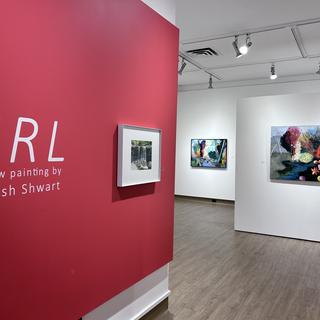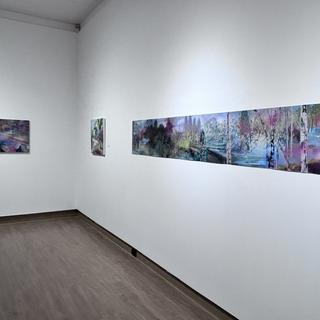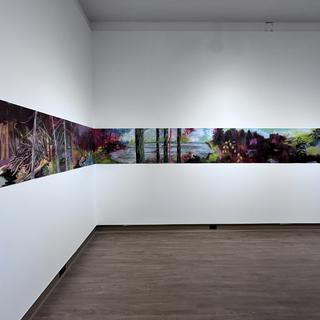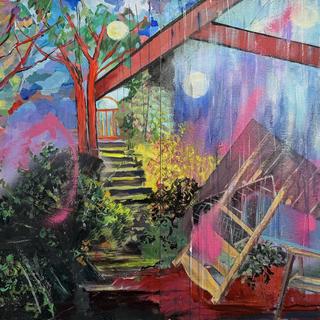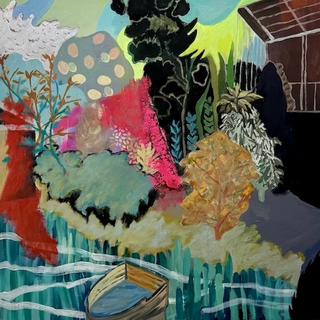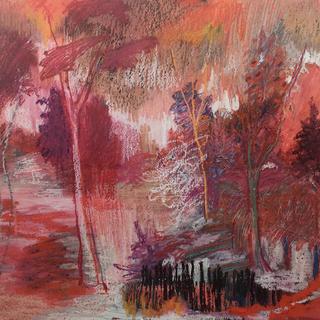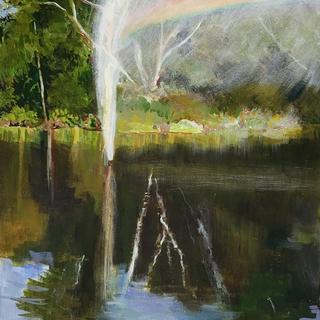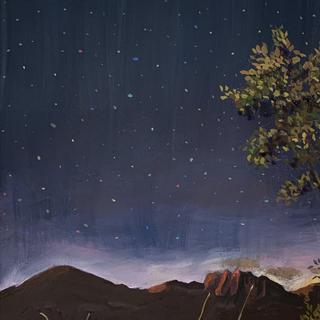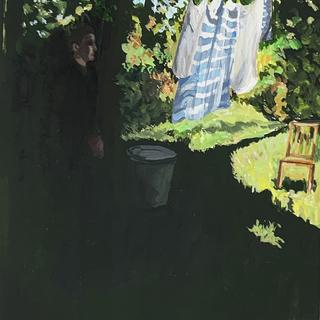Holocene Daydream (Nation)
A response to IRL: New Painting by Trish Shwart
by Kegan McFadden
Trish Shwart scatters her sparsely populated paintings with evidence of us: Abandoned vehicles, empty buildings with lights left on, monuments to once consequential histories as well as the overlooked, unremarkably lovely bits, and more, dotting long panoramic landscapes and nuanced singular vignettes made in response to the question, “How will an extinction event play out?”[1]
These aren’t nightmares, but perhaps daydreams. Quite possibly, they are memories… Is there a difference? Daydreaming is really just a plot for a future memory (if we’re lucky). The shorthand adopted to title this exhibition, IRL is an artifact from the early days of the world wide web to signify the difference between ‘in real life’ and what would, or could, be taking shape in the digital realm… the place, at least some time ago, that would propel and hold our daydreams. Now, it seems, the internet has become a graveyard of our sad memories and a breeding ground for our worst nightmares.
There’s a house at the end of my block that borders the water which bisects the west from the east of the city where I live. It’s a west coast modernist design with sloping roof and too many windows to count, hidden just barely out of sight, amongst a mess of Cedar trees, Laurel bushes, and one enormous Sitka. When I walk my dog along that parcel of the street, I daydream what lies behind the bright orange door of this house at the end of a long driveway. Or maybe this house is in a part of Porto, Portugal, where I’ve never been … a future memory.
It’s this slippage of what is, was, could be, that Shwart presents to her audience; still, we recognize the chair as a chair, a sidewalk or path as a conveyance, a fence as an impediment, and the various shorelines as invitations to lay alongside –daydreaming– on warm afternoons. Shwart began this body of work during the dark days of the pandemic, using old snapshots she’d taken decades earlier with the intention to incorporate these images into paintings before the tasks of day-to-day waking life took precedence, only to reemerge just in time for the world to hold still. Amidst her palette of warm fuchsia and cool cobalt, of sketchy pastel shading, bold acrylic lines, and glossy spray paint, it’s what we don’t see –what is denied, or withheld– that allows us to claim this daydream nation as our own for a moment. Don’t get lost in the once used playground equipment, the discarded oil drums, the ghost of scaffolding; these aren’t our memories.
When my mind drifts to that house, down the block from me, leash in hand while my dog sniffs the Cedar boughs, I imagine lighting a joint on the porch overlooking the water, at dusk; or a handsome bearded man with kinds eyes reading to me; or the two of us stripping down and fumbling into the water as night falls; or the smell of barbecue; what it would feel like, in the first cold months of the winter along the windswept shore, and then the reciprocal calm damp spring with the tiny budding yellow and purple Crocuses emerging between the large tree trunks and a tipped over canoe. How many rooms might it have, and which would hold my library? Just before the daydream subsides, I wonder how many people the inhabitants of this home have witnessed drown in the waters that current their shore.
Shwart’s series of gouache on paper, Stolen Moments, are a response to the day-to-day demands associated with raising children and working a full time job rather than what would otherwise be time spent communing with the landscape and/or making paintings in the studio. These unacted upon, or perhaps cribbed memories, decades later become a platform for the artist to now contemplate: A rainbow’s prism emanating from a waterspout mid-lake, the reflection of Birch trees on the water echoing roots; the night sky dotted with incandescent stars mirroring the lowland brush each at opposite ends of a deep blue night sky but both vying for attention; a waterfall whose cascade resembles delicate lace, like a veil pooling in the material of its own making. In each painting, there is a singular point of view, zeroing in on a solitude that is both introspective and speculative.
The scrape of land echoes the language of flowers[2], known only among themselves, from root to receptacle, petal to pistils, and stamen to sunbeam. This language would be incomprehensible to us, but just as our languages are full of references to flora, might theirs, too, carry a small obsession with our brief human lives? And if this isn’t about daydreaming… If this is closer to recollections informed by lived experiences, good and bad… If daydreaming isn’t a future memory but in fact a rich withdrawal from real life… What then? When our language finally dies out, will there still be flowers? And if so, will they remember the heap of names we gave to them? Will they remember us and all of the silly, disastrous things we do or have done?
I wasn’t one of those kids who made blanket forts, but these nonspecific sites Shwart depicts across her recent body of work offers the intimacy of such places (or so I presume)… where whispers between friends become doctrine, daylight exists as an idea only as long as the eyelids allow, and the miraculous is found in fifteen more minutes before dinner. These sites become monuments in a similar way –edifices to memory, daydreams of what could still become– dotting the infrastructure of our time.
I breach the garden of the house with the orange door where, at the foot of a Japanese Maple, I find a discarded piece of driftwood that resembles the head of an animal in profile. I pick it up; it’s too big to fit in my jacket pocket so I carry it in one hand, the other embraces the braided leash of my dog. It looks like a rhinoceros who fell victim to ivory poachers; its once humbling horn now missing, making a sad face even more morose. Wikipedia tells us that rhinoceroses are some of the largest remaining megafauna and each weigh over half a tonne in adulthood. They have a herbivorous diet, and small brains of 400–600 grams but can live up to forty-five years. As I type this essay, there remain 28,000 rhinoceroses worldwide. Spell the word rhinoceros. Say the word rhinoceros aloud… twenty-eight thousand times, in twenty-eight thousand languages. Our resonant sibilant ‘s’, repeated over and over, will still not be enough to regrow her horn.
This pastiche of information, pulled from the digital realm to reinforce aspects of Shwart’s paintings, is more than an exercise in collage… it might just also be theory in practice, taking a page from the artist’s own approach to her work. In the newest paintings, from the series On the Precipice, we see hints of collage (re)surfacing elements such as trees, and when employed they take on the illusion of digital glitches that suggest not all is as it might appear ‘naturally.’ Purple Cedars, overgrown lilies, stylized rocks and leaves abound, a once straight column becomes jumpy and jagged, ultimately leaving us to question what is ‘real.’ These new works are in response to the mediated version of the natural world we’ve all become accustomed to via digital screens[3], but it also forces the question: how will our future memories (and daydreams) be formed? What visual information will be pieced together when we remember a walk through the forest, or spending time in our gardens? Shwrt has painted these scenes in the hope that such environs continue to thrive during whatever might follow this Holocene daydream.
There have been a handful of major extinction events this rock called Earth has witnessed, the oldest occurring 445 million years ago (resulting in the demise of many small marine organisms and signaling the end of the Ordovician period) and most recently 65 millions years (when three-quarters of the plant and animal species on Earth were whipped out). Each extinction event, to date (major or minor), has been due to natural occurrences: climate change, volcanic activity, asteroid impacts, and biological changes, though it is widely accepted that the next such event, marking the end of our Holocene epoch, will be the result of humankind irl.
I keep writing ‘us’ and ‘our’ in the hopes that you’ll read this and think maybe it’s you and me I’m calling into the picture. And I know there’s many ‘we’ that have yet to be formed, and so I would suggest, dear reader, that instead of trying to picture me, you assume the active role in ‘us’ and superimpose your own wayward memory, best friend, fort builder, mother Rhino into this equation. Once ‘we’re’ together, take me to the water and tell me again, how we got there, and where everyone else has gone.
Kegan McFadden
____________________
Curator, poet, and writer, Kegan McFadden lives on Vancouver Island and met Trish Shwart through his role as Executive Director with the Victoria Arts Council, a position he’s held since 2018. His criticism and parallel texts have been commissioned throughout Canada’s artist-run network, as well as public and university galleries, in addition to appearing in Border Crossings, Canadian Art, C-Magazine, fuse, Visual Arts News among other journals over the last twenty years. Across these platforms, his writing has been translated into French, Inuktitut, Japanese, and Spanish.
[1] Trish Shwart, “Markers of Time” artist statement (September, 2024).
[2] The language of flowers is borrowed here from Pat Martin Bates, who invoked the idea during her presidential closing remarks at the Victoria Visual Arts Legacy Society annual bursary awards night in 2023.
[3] “On screen, the wild landscape appears dramatic and intense. Colors are extreme, and the accelerated movements of the sky or a running animal feel hyperreal. The more subtle elements of the natural world can seem less authentic than the immersive digital realm.” (Artist Statement, Landscape and Technology (June 2024)

